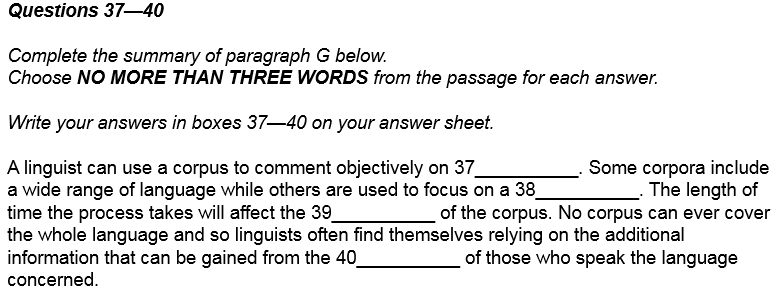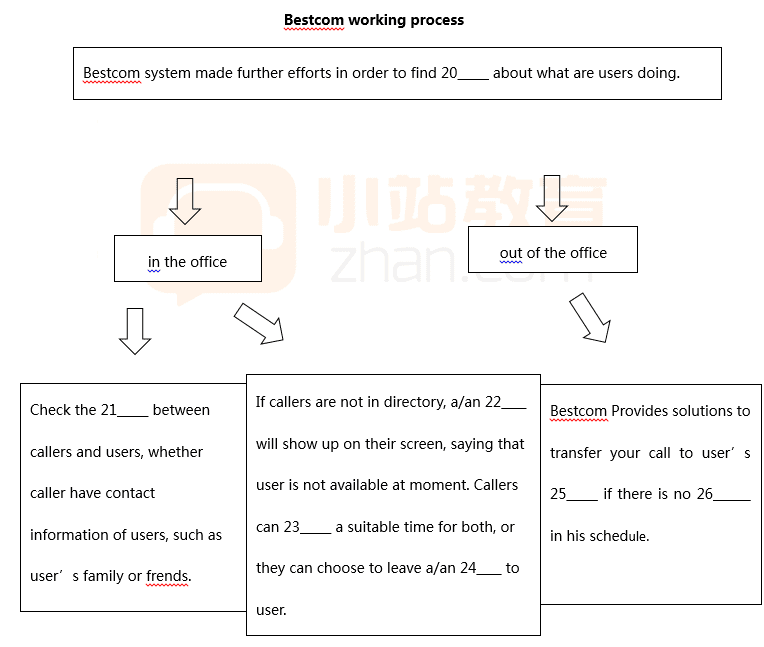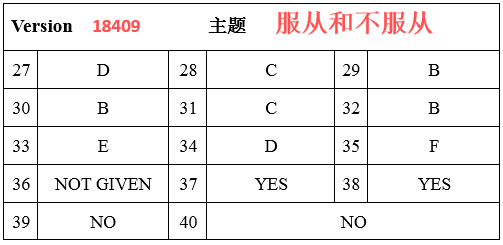今天给大家带来了托福阅读简化题高正确率解题技巧思路汇总,希望能够帮助到大家在托福考试中拿高分,下面小编就和大家分享,来欣赏一下吧。
托福阅读简化题高正确率解题技巧思路汇总分享
托福阅读简化题题型简介
托福阅读句子简化题针对的是托福阅读文章中有些难度的句子,题目问法常常是固定的:Which of the sentences below best expresses the essential information in the highlighted sentence? Incorrect answer choices change the meaning in important ways or leave out essential information.考生在答题时,可以根据文章中的背景句子来马上找到句子出处。
托福阅读简化题选项特点
托福阅读句子简化题的正确选项一定包含了原句的主要意思,同时在逻辑上不会有变化。而根据题干中错误选项特征描述“change the meaning in important ways”、“leave out essential information”,可知该题型错误选项会遗漏原句的重要信息或者是加入原句中没有的意义。
托福阅读简化题答题方法
考生在解答这类题型时,一般步骤分为三步:①首先看句子的类型是简单句还是复杂句,简单句即只有主、谓、宾没有其他修饰成分的句子,复杂句则是加入了一些修饰性成分,往往不容易一眼看出重点的句子。②根据上一步的判断,如果是复杂句,需要考生先找出句子主干,如果是简单句,则不需要,接下来则需要分析句子中有没有明显的逻辑关系,判断标准是利用句子中的逻辑关联词,比如指示因果关系的有:Therefore, due to, as, for, thus, hence, consequently以及能够表达“引起、造成”、“起源于、由…而来”意义的词,指示并列关系的标志词是:also, both…and…, either...or..., equally, similarly 等。③在确定了句子主干和逻辑之后,接下来需要对选项中句子作简要分析,核对选项的逻辑和主干是不是和原句一致。
托福阅读简化题答题技巧
句子简化题的以上答题方法比较繁琐,考生需要分析原句和选项句5个句子才能评判出答案。所以在这个题型解答中考生如果可以掌握一些技巧必定能减轻不少负担。这类题型的答题技巧其实正是来自于上述方法:逻辑解题法。逻辑解题依据的是句子的改写不会改变句子逻辑这个原理。考生可以结合并列逻辑和托福阅读句子简化题来查看具体示例。
托福阅读简化题注意事项
考生可以了解到这类题型考察的是句子的理解,所以很多考生可能会利用“翻译”方式来理解这个句子,要知道这种解题方法会使得考生的工作量加大,而且往往翻译有时候并不能表现原句的逻辑概念,会造成考生的理解偏差,所以大家应该避免。
托福考试阅读文章练习
Although only 1 person in 20 in the Colonial period lived in a city, the
cities had a disproportionate influence on the development of North America.
They were at the cutting edge of social change. It was in the cities that the
elements that can be associated with modern capitalism first appeared — the use
of money and commercial paper in place of barter, open competition in place of
social deference and hierarchy, with an attendant rise in social disorder, and
the appearance of factories using coat or water power in place of independent
craftspeople working with hand tools. "The cities predicted the future," wrote
historian Gary. B. Nash, "even though they were but overgrown villages compared
to the great urban centers of Europe, the Middle East and China."
Except for Boston, whose population stabilized at about 16,000 in 1760,
cities grew by exponential leaps through the eighteenth century. In the fifteen
years prior to the outbreak of the War for independence in 1775, more than
200,000 immigrants arrived on North American shores. This meant that a
population the size of Boston was arriving every year, and most of it flowed
into the port cities in the Northeast. Philadelphia’s population nearly doubted
in those years, reaching about 30,000 in 1774, New York grew at almost the same
rate, reaching about 25,000 by 1775.
The quality of the hinterland dictated the pace of growth of the cities.
The land surrounding Boston had always been poor farm country, and by the
mid-eighteenth century it was virtually stripped of its timber. The available
farmland was occupied, there was little in the region beyond the city to attract
immigrants. New York and Philadelphia, by contrast, served a rich and fertile
hinterland laced with navigable watercourses. Scots, Irish, and Germans landed
in these cities and followed the rivers inland. The regions around the cities of
New York and Philadelphia became the breadbaskets of North America, sending
grain not only to other colonies but also to England and southern Europe, where
crippling droughts in the late 1760’s created a whole new market.
1. Which of the following aspects of North America in the eighteenth
century does the passage mainly discuss?
(A) The effects of war on the growth of cities
(B) The growth and influence of cities
(C) The decline of farming in areas surrounding cities
(D) The causes of immigration to cities
2. Why does the author say that "the cities had a disproportionate
influence on the development of North America" (lines 1-2)?
(A) The influence of the cities was mostly negative
(B) The populations of the cities were small, but their influence was
great.
(C) The cities were growing at a great rate.
(D) Most people pretended to live in cities
3. The phrase "in place of " in lines 4-5 is closest in meaning to
(A) connected to
(B) in addition to
(C) because of
(D) instead of
4. The word "attendant" in line 6 is closest in meaning to
(A) avoidable
(B) accompanying
(C) unwelcome
(D) unexpected
5. Which of the following is mentioned as an element of modern
capitalism?
(A) Open competition
(B) Social deference
(C) Social hierarchy
(D) Independent craftspeople
6. It can be inferred that in comparison with North American cities, cities
in Europe, the Middle East, and China had
(A) large populations
(B) little independence
(C) frequent social disorder
(D) few power sources
7. The phrase "exponential leaps" in line 12 is closest in meaning to
(A) long wars
(B) new laws
(C) rapid increases
(D) exciting changes
8. The word "it" in line 15 refers to
(A) population
(B) size
(C) Boston
(D) Year
9. How many immigrants arrived in North America between 1760 and 1775?
(A) About 16,000
(B) About 25,000
(C) About 30,000
(D) More than 200,000
10. The word "dictated" in line 18 is closest in meaning to
(A) spoiled
(B) reduced
(C) determined
(D) divided
11. The word "virtually" in line 20 is closest in meaning to
(A) usually
(B) hardly
(C) very quickly
(D) almost completely
12. The region surrounding New York and Philadelphia is contrasted with the
region surrounding Boston in terms of
(A) quality of farmland
(B) origin of immigrants
(C) opportunities for fishing
(D) type of grain grown
13. Why does the author describe the regions around the cities of New York
and Philadelphia as "breadbaskets"?
(A) They produced grain especially for making bread.
(B) They stored large quantities of grain during periods of drought
(C) They supplied grain to other parts of North America and other
countries.
(D) They consumed more grain than all the other regions of North
America.
BBDBA ACADC DAC
托福考试阅读文章练习
The spectacular aurora light displays that appear in Earth’s atmosphere
around the north and south magnetic poles were once mysterious phenomena. Now,
scientists have data from satellites and ground-based observations from which we
know that the aurora brilliance is an immense electrical discharge similar to
that occurring in a neon sign.
To understand the cause of auroras, first picture the Earth enclosed by its
magnetosphere, a huge region created by the Earth’s magnetic field. Outside the
magnetosphere, blasting toward the earth is the solar wind, a swiftly moving
plasma of ionized gases with its own magnetic filed. Charged particles in this
solar wind speed earthward along the solar wind’s magnetic lines of force with a
spiraling motion. The Earth’s magnetosphere is a barrier to the solar winds, and
forces the charged particles of the solar wind to flow around the magnetosphere
itself. But in the polar regions, the magnetic lines of force of the Earth and
of the solar wind bunch together. Here many of the solar wind’s charged
particles break through the magnetosphere and enter Earth’s magnetic field. They
then spiral back and forth between the Earth’s magnetic poles very rapidly. In
the polar regions, electrons from the solar wind ionize and excite the atoms and
molecules of the upper atmosphere, causing them to emit aurora radiations of
visible light.
The colors of an aurora depend on the atoms emitting them. The dominant
greenish white light comes from low energy excitation of oxygen atoms. During
huge magnetic storms oxygen atoms also undergo high energy excitation and emit
crimson light. Excited nitrogen atoms contribute bands of color varying from
blue to violet. Viewed from outer space, auroras can be seen as dimly glowing
belts wrapped around each of the Earth’s magnetic poles. Each aurora hangs like
a curtain of light stretching over the polar regions and into the higher
latitudes. When the solar flares that result in magnetic storms and aurora
activity are very intense, aurora displays may extend as far as the southern
regions of the United States.
Studies of auroras have given physicists new information about the behavior
of plasmas, which has helped to explain the nature of outer space and is being
applied in attempts to harness energy from the fusion of atoms.
1. What does the passage mainly discuss?
(A) The methods used to observe auroras from outer space
(B) The formation and appearance of auroras around the Earth’s poles
(C) The factors that cause the variety of colors in auroras
(D) The periodic variation in the display of auroras
2. The word "phenomena" in line 2 is closest in meaning to
(A) ideas
(B) stars
(C) events
(D) colors
3. The word "picture" in line 5 is closest in meaning to
(A) frame
(B) imagine
(C) describe
(D) explain
4. The passage describes the magnetosphere as a barrier (line 10)
because
(A) its position makes it difficult to be observed from Earth
(B) it prevents particles from the solar wind from easily entering Earth’s
atmosphere
(C) it increases the speed of particles from the solar wind
(D) it is strongest in the polar regions
5. The word "them" in line 16 refers to (A) polar regions
(B) electrons
(C) atoms and molecules
(D) aurora radiations
-
6. According to the passage , which color appears most frequently in an
aurora display?
(A) greenish-white
(B) crimson
(C) blue
(D) violet
7. The word "emit" in line 20 is closest in meaning to
(A) change from
(B) connect with
(C) add to
(D) give off
8. The word "glowing" in line 22 is closest in meaning to
(A) shining
(B) moving
(C) charging
(D) hanging
9. Auroras may be seen in the southern regions of the United Sates when
(A) magnetic storms do not affect Earth
(B) solar flares are very intense
(C) the speed of the solar wind is reduced
(D) the excitation of atoms is low
10. The passage supports which of the following statements about
scientists’ understanding of auroras?
(A) Before advances in technology, including satellites, scientists knew
little about auroras.
(B) New knowledge about the fusion of atoms allowed scientists to learn
more about auroras.
(C) Scientists cannot explain the cause of the different colors in
auroras.
(D) Until scientists learn more about plasma physics, little knowledge
about auroras will be available.
11. Which of the following terms is defined in the passage ?
(A) "magnetosphere" (line 6)
(B) "electrons" (line 15)
(C) "ionize" (line 15)
(D) "fusion" (line 29)
BCBBC ADABA A





